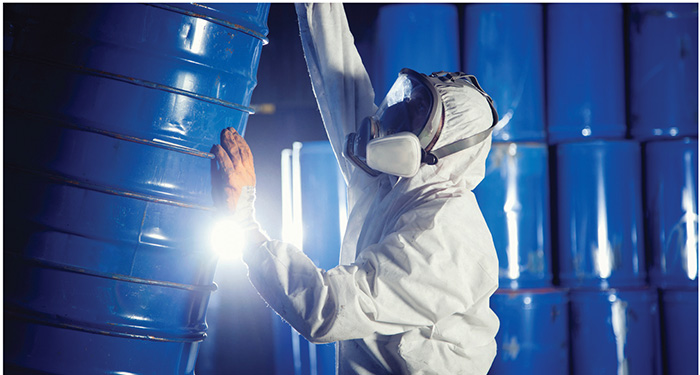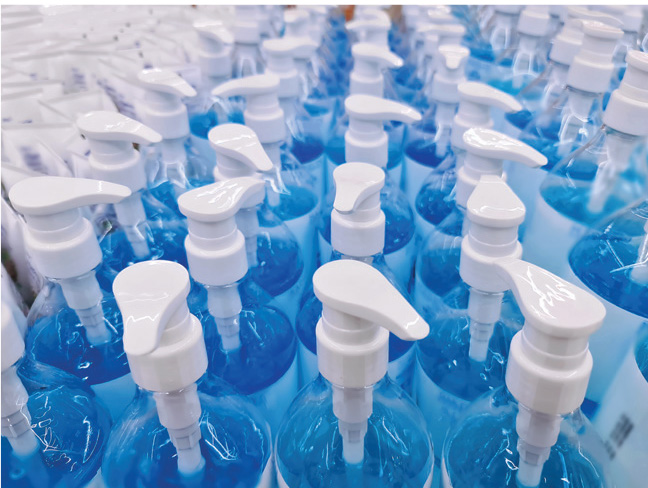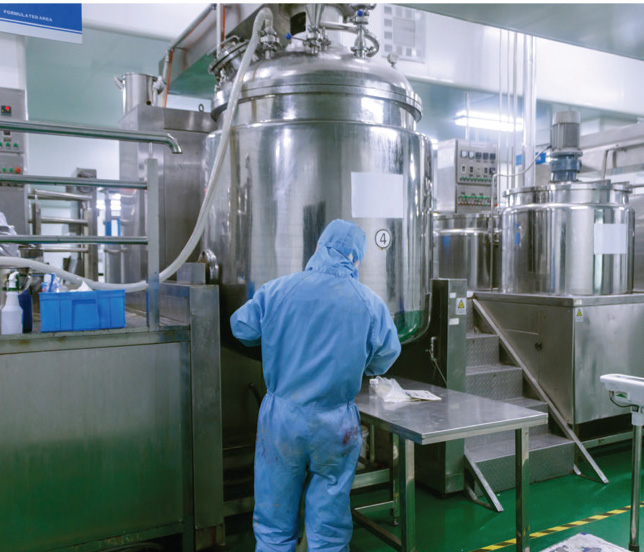When making a change in your process, do not overlook new potential hazards that may arise, as discussed here
Large-scale chemical processing can be inherently risky. This is especially important to keep in mind when making changes to a process. As we have seen recently during the COVID-19 pandemic, many companies have begun creating essential new products, from hand sanitizer to plastic face shields. If new raw materials are used, or if existing equipment is used to create a new product, the associated hazards may also change. During an emergency, once a new process is operating, it is easy to overlook any new risks that have been created. Many factors must be considered, and some may require council from a fire- and life-safety professional. Among the major considerations for confirming that fire and life safety systems are adequate for your process are: ensuring the proper storage of hazardous material, considering the risk of the process to the facility, and system maintenance.
Storing new hazardous materials
A major factor that should be examined in detail when making any changes to a chemical process is the storage of any new hazardous materials (Figure 1). These can be raw materials, finished products or waste. Just a few considerations include the specifics on how to store these materials, as well as the overhead fire sprinkler protection required for the specific hazard posed. Some of the top fire and life safety hazards are flammable and combustible liquids (such as ethanol, isopropyl alcohol, gasoline or any oil derivative), dust hazards (created from such operations as milling, agricultural and food processing), and Group A plastics.
While the risk posed by storage of any hazardous material should always be considered, this has become particularly imperative during the pandemic. When personal protective equipment (PPE) shortages hit the doctors, nurses and first responders, many people asked themselves: what can I do to help? The answer for some was to make masks at home with scraps of fabric and their sewing machines, while others went to work reconfiguring their equipment to produce plastic face shields, ventilators and even hand and surface sanitizers. This has caused many professional processes to operate outside of their original design parameters. Consequently, some facilities started storing and utilizing large quantities of flammable and combustible liquids and Group A plastics that were not storing these items before.

Figure 1. A new process could entail the storing of new hazardous materials, such as flammable sol
One example is the local wineries and breweries that began making and distributing hand and surface sanitizers. It is important to note, the average alcohol content of beer is approximately 5% and wine is approximately 12%, according to the National Institute on Alcohol Abuse and Alcoholism [1]. The alcohol content of the sanitizing products ranges from 60 to 80%. While the intent of this creative way to support the community is noble, fire protection systems in these facilities may not be capable of adequately protecting the increased hazard that comes from storing and processing large quantities of a highly flammable liquid (Figures 1 and 2). For instance, fire- and life-safety systems designed for distilleries must consider the quantity of spirit that will be maintained on-site in order to appropriately protect the facility and people within it. Breweries and wineries often do not require the same level of protection.

Figure 2. Fire protection systems in facilities that have changed production to hand sanitizer, which has a high alcohol content, may not be capable of adequately protecting the increased hazard that comes from storing large quantities of flammable liquids
Additionally, companies from many industries have started producing medical equipment, such as plastic face shields, face masks and ventilators. Most notable are the companies in the automobile industry, but local manufacturers of electrical equipment and furniture have also answered the call. Medical products are subject to strict regulation that extends to how the products are manufactured (Figure 3). Not only can the onsite storage of hazardous materials (think Group A plastics used for the plastic face shields) change, but the facility may also undergo structural changes to comply with the requirement to maintain a dust-free manufacturing environment.

Figure 3. Medical products are subject to strict regulation that extends to how the products are manufactured
One of the main hazards associated with converting production to plastic face shields, from either a less hazardous process or a process posing a different risk, is the storage of Group A plastics. This type of plastic is classified by having a higher heat of combustion and a higher burning rate than other plastics and includes materials such as polyethylene terephthalate (PET), natural rubber, polypropylene, acrylic and polyvinyl chloride (PVC). These plastics can be especially hazardous in a fire because they ignite quickly and easily but also burn incredibly hot. Protection for storage of this classification of plastics is generally much more stringent compared to storage requirements for other items.
A few key questions to answer while considering the storage of non-native materials in your facility are as follows:
- Where is the hazardous material being stored?
- What is the proper container for storage of this material?
- How much will be stored?
- If a large quantity will be stored, how will it be stored? Will racks or shelving be used? What else might be stored nearby or within the same racking?
- Do the building materials and construction of this facility support this type of storage?
Again, it is important to consider retaining the services of a fire- and life-safety professional when making changes to your facility.
Process risks to the facility
When a chemical process is being developed, it is expected that a hazard and operability study (HAZOP), hazard identification study (HAZID), or another method of “what-if” analysis will take place before and during the development. This type of study often starts small, by breaking the process down by each piece of equipment and imagining worst-case scenarios, in order to prevent or plan for them. The study then, effectively, “zooms out” further and further, until the entire process is viewed and analyzed. This exercise is very effective in preventing everything from everyday problems to catastrophic situations. Nonetheless, the analysis is often not viewed from a great enough distance to include the facility containing the process or the storage of the materials.
It is easy to mitigate risk and anticipate problems when a facility is being designed specifically for a process. This allows the fire sprinkler system to be designed with a specific risk in mind, the proper fire walls to be installed, necessary ventilation, and so on. It is not as easy to avoid these types of problems when changing a process in an existing infrastructure. The building materials, adjacent spaces, type of construction, even nearby structures can affect what type of fire protection is required for a specific hazard.
The manufacturing of medical equipment in unrelated production facilities has led to changes in infrastructure to comply with U.S. Food and Drug Administration (FDA) regulations. In order to create the required dust-free environment, changes would typically include installation of walls or partitions and ventilation systems. Changes of this nature, even if only temporary, can create obstructions to the sprinkler system or cause the sprinkler heads to be over spaced. In either case, the primary concern is the sprinkler heads being unable to develop the appropriate spray pattern to reach all affected commodities and structures. This is a common occurrence when a new process takes over an existing space. Meeting ventilation requirements or even creating a space that is ideal for your process by adding or removing walls can greatly impact the fire protection criteria.
Sometimes the solution may be as simple as a few minor upgrades to the fire protection system or rethinking a storage arrangement, whereas other times it may be necessary to install a completely new system. When working with hazardous materials, such as flammable and combustible liquids, plastics or even combustible dust, it is important to know your facility has been designed with the protection of your process in mind.
System maintenance
The final consideration when confirming that the fire- and life-safety systems are adequate for your process is system maintenance. Once the risk has been correctly categorized, the proper fire- and life-safety protections have been installed, and the process is operational, it is easy to take the protection for granted, especially during a global emergency. Nevertheless, as is the case with most equipment, the fire-protection and life-safety systems require regular testing, inspections, and maintenance.
Fire safety inspections extend beyond the overhead sprinkler system to include fire alarms, smoke and heat detection, and inspection of fire doors and emergency exits. Most wet-sprinkler systems require annual inspections, with some components of the system requiring quarterly inspections. If your process is protected by a foam-water sprinkler system, monthly inspections may be required. While this may seem excessive, regular testing and inspections are necessary to ensure that the fire- and life-safety systems will perform as expected in the case of a fire-related emergency.
According to a National Fire Protection Association (NFPA) study published in 2018 of the fire incidents in industrial and manufacturing occupancies between 2011 and 2015, only 20% were structural fires [ 2]. However, structural fires lead to the most loss and damage — with 49% of deaths, 80% of injuries, and 67% of direct property damage being cause by a structural fire. Manufacturing and processing facilities were responsible for 65% of the fires, which caused six deaths, 176 injuries and $540 million in property damage. Regular inspection, testing and maintenance can address any issues that arise in a timely manner and ensure your system is functioning properly.
Final thoughts
Whenever a change to a process is being implemented, it is important to consider any risks that may be created outside of the process equipment. This is especially important when introducing hazardous materials, such as flammable and combustible liquids and Group A plastics. Whether the risk is created by the raw materials, waste, or final product, the storage of any such materials and their associated fire hazards must be taken into consideration in order to ensure the fire- and life-safety systems can protect against the increased risk created by the materials and their storage arrangement.
If it becomes necessary to change existing infrastructure to accommodate a new process or if a change in process results in the addition or removal of any walls or ventilation systems, the impact on the installed fire- and life-safety systems must be taken into account. Changes such as the ones previously mentioned can have a big impact on the general safety of your building. Additionally, it is imperative that regular required testing, inspection and maintenance of these systems continue. Failing to properly maintain the fire- and life-safety equipment can result in millions of dollars of property damage, injury, and in some cases, death, if an emergency were to occur.
While addressing risk within the process is imperative, equally significant is examining the building or facility housing the process and how the raw material, products and waste are being handled within the facility. Including or consulting with a professional who has experience working with the International codes and the national standards will increase not only the protection of your process, but more importantly, the safety of your people.
References
1. www.niaaa.nih.gov/what-standard-drink.
Author
 McKenna Pearson is a fire protection consultant for Telgian Engineering & Consulting, LLC (900 Circle 75 Parkway, Suite 680, Atlanta, GA 30339; Email: [email protected]) with more than three years of professional experience in the industry. Pearson collaborates with both team members and public agencies to manage, develop, integrate and analyze project schedules and expedite objectives. She assists clients by helping them to focus on critical activities to accomplish ultimate project and production goals. Pearson is responsible for reviewing existing fire alarm, suppression and life-safety systems. Her role requires her to uphold a working knowledge of relevant fire protection, risk, building codes and construction technologies. She also builds and maintains relationships with clients and officials. In addition to ensuring operational functionality and code and standards compliance, she responds to proposals, meets with stakeholders, and ensures project deadlines are met. McKenna has earned a B.S.Ch.E. degree from Montana State University-Bozeman and has received her EIT license.
McKenna Pearson is a fire protection consultant for Telgian Engineering & Consulting, LLC (900 Circle 75 Parkway, Suite 680, Atlanta, GA 30339; Email: [email protected]) with more than three years of professional experience in the industry. Pearson collaborates with both team members and public agencies to manage, develop, integrate and analyze project schedules and expedite objectives. She assists clients by helping them to focus on critical activities to accomplish ultimate project and production goals. Pearson is responsible for reviewing existing fire alarm, suppression and life-safety systems. Her role requires her to uphold a working knowledge of relevant fire protection, risk, building codes and construction technologies. She also builds and maintains relationships with clients and officials. In addition to ensuring operational functionality and code and standards compliance, she responds to proposals, meets with stakeholders, and ensures project deadlines are met. McKenna has earned a B.S.Ch.E. degree from Montana State University-Bozeman and has received her EIT license.